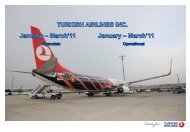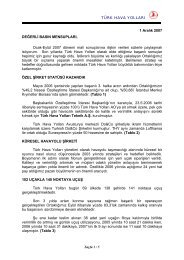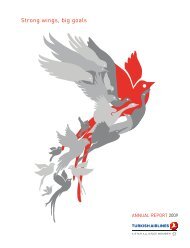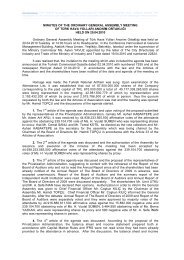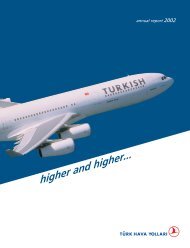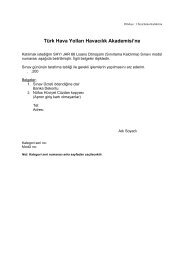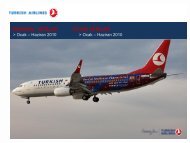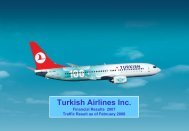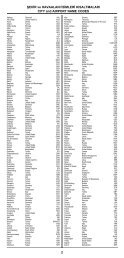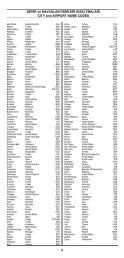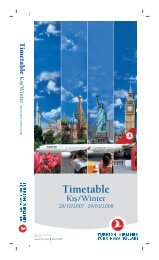Financial - Turkish Airlines
Financial - Turkish Airlines
Financial - Turkish Airlines
- No tags were found...
Create successful ePaper yourself
Turn your PDF publications into a flip-book with our unique Google optimized e-Paper software.
(Convenience Translation of Report and <strong>Financial</strong> Statements Originally Issued in <strong>Turkish</strong>)TÜRK HAVA YOLLARI ANONİM ORTAKLIĞI AND ITS SUBSIDIARIESNotes to the Audited Consolidated <strong>Financial</strong> StatementsFor the Year Ended 31 December 2012(All amounts are expressed in <strong>Turkish</strong> Lira (TL) unless otherwise stated.)Amendments to IAS 1 Presentation of Items of Other Comprehensive IncomeThe amendments to IAS 1 Presentation of Items of Other Comprehensive Income is effective for the annual periodsbeginning on or after 1 July 2012. The amendments introduce new terminology for the statement of comprehensiveincome and income statement. Under the amendments to IAS 1, the ‘statement of comprehensive income’ is renamedthe ‘statement of profit or loss and other comprehensive income’ and the ‘income statement’ is renamed the ‘statementof profit or loss’. The amendments to IAS 1 retain the option to present profit or loss and other comprehensive incomein either a single statement or in two separate but consecutive statements. However, the amendments to IAS 1 requireitems of other comprehensive income to be grouped into two categories in the other comprehensive income section:(a) items that will not be reclassified subsequently to profit or loss and (b) items that may be reclassified subsequentlyto profit or loss when specific conditions are met. Income tax on items of other comprehensive income is required tobe allocated on the same basis - the amendments do not change the option to present items of other comprehensiveincome either before tax or net of tax. The amendments can be applied retrospectively. Other than the above mentionedpresentation changes, the application of the amendments to IAS 1 does not result in any impact on profit or loss, othercomprehensive income and total comprehensive income.Amendments to IAS 1 Presentation of <strong>Financial</strong> Statements(as part of the Annual Improvements to IFRSs 2009-2011 Cycle issued in May 2012)The amendments to IAS 1 as part of the Annual Improvements to IFRSs 2009-2011 Cycle are effective for the annualperiods beginning on or after 1 January 2013.IAS 1 requires an entity that changes accounting policies retrospectively, or makes a retrospective restatement orreclassification to present a statement of financial position as at the beginning of the preceding period (third statementof financial position). The amendments to IAS 1 clarify that an entity is required to present a third statement of financialposition only when the retrospective application, restatement or reclassification has a material effect on the informationin the third statement of financial position and that related notes are not required to accompany the third statement offinancial position.IFRS 9 <strong>Financial</strong> InstrumentsIFRS 9, issued in November 2009, introduces new requirements for the classification and measurement of financialassets. IFRS 9 was amended in October 2010 to include requirements for the classification and measurement offinancial liabilities and for derecognition.Key requirements of IFRS 9:• All recognized financial assets that are within the scope of IAS 39 <strong>Financial</strong> Instruments: Recognition andMeasurement to be subsequently measured at amortized cost or fair value. Specifically, debt investments that areheld within a business model whose objective is to collect the contractual cash flows, and that have contractualcash flows that are solely payments of principal and interest on the principal outstanding are generally measuredat amortized cost at the end of subsequent accounting periods. In addition, under IFRS 9, entities may make anirrevocable election to present subsequent changes in the fair value of an equity investment (that is not held fortrading) in other comprehensive income, with only dividend income generally recognized in profit or loss.• With regard to the measurement of financial liabilities designated as at fair value through profit or loss, IFRS 9requires that the amount of change in the fair value of the financial liability that is attributable to changes inthe credit risk of that liability, is presented in other comprehensive income, unless the recognition of the effectsof changes in the liability’s credit risk in other comprehensive income would create or enlarge an accountingmismatch in profit or loss. Changes in fair value attributable to a financial liability’s credit risk are not subsequentlyreclassified to profit or loss. Previously, under IAS 39, the entire amount of the change in the fair value of thefinancial liability designated as at fair value through profit or loss was presented in profit or loss.12 TÜRK HAVA YOLLARI ANNUAL REPORT 2012



